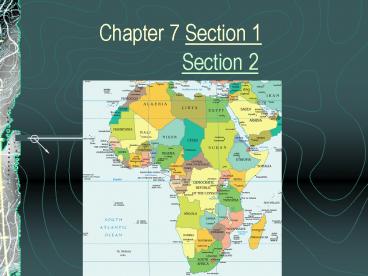Chapter 7 Section 1 - PowerPoint PPT Presentation
1 / 45
Title:
Chapter 7 Section 1
Description:
Chapter 7 Section 1 Section 2 Many African societies were matrilineal Descent was traced through the mother. Religious Beliefs Rituals were a way to communicate with ... – PowerPoint PPT presentation
Number of Views:178
Avg rating:3.0/5.0
Title: Chapter 7 Section 1
1
Chapter 7 Section 1
Section 2
2
Kush and Axum were strong civilizations. Later,
Islam would influence Africa.
3
About 800,000 years ago, hunters and gatherers in
Africa began to tame animals and grow crops.
4
This was called the Agricultural Revolution.
5
It gave rise to Africas first civilizations
Kush and Axum.
6
Kush
7
By 2000BC trade had arisen between Egypt and the
area to the South called Nubia.
8
Nubia was subject to Egyptian control for many
years. But they freed themselves in 1000BC and
became the independent state of Kush.
9
In 750BC, Kush conquered Egypt.
10
But, eventually the Assyrians (armed with better
weapons) would drive them out of Egypt. The
Kushites would return to the upper Nile valley.
11
Their economy was first based on farming. But,
soon they would be trading.
12
They would establish a major trading network
providing iron, ivory, gold and slaves to the
Roman Empire, Arabia and India.
13
Axum
14
Kush flourished from 250BC-AD150. It declined
because of the rise of Axum.
15
Axum was after ivory and Kush had it. Axum
invaded Kush and took over.
16
Axum was located in what is now Ethiopia.
17
Axum was founded by Arabs. It owed its
prosperity to the Red Sea.
18
It was on the trade route between India and the
Mediterranean.
19
The most distinctive feature of its civilization
was its religion.
20
King Ezana (the Axumite ruler) converted to
Christianity and made it the Axum religion.
21
Please read the section entitled Rise of Islam.
Summarize the information in your notes.
22
Chapter 7 Section 2
Did You Know?
- Mansa Musa, the Islamic ruler was accompanied on
his pilgrimage to Makkah by a caravan consisting
of 60,000 men and a baggage train of 80 camels,
each carrying 300 pounds of gold.
23
THE KINGDOM OF GHANA
24
First of the great West Africa Trading States.
Most people were farmers who lived in villages
that together formed the kingdom of Ghana.
25
The Kings of Ghana were strong, wealthy rulers
They governed without any laws
Had a well trained army of thousands of soldiers
26
Ghana prospered from Iron and Gold supplies.
Traded gold for salt.
- Salt was a highly desired item, was used to
preserve food and to improve its taste, - People also needed it to replace what there
bodies lost in the hot climate.
27
THE BERBERS
A.K.A. fleets of the desert
28
Camel caravans carried much of the trade across
the desert.
- Took 40-60 days to reach their destination
- Typically, up to a hundred camels traveled at
about three miles an hour.
29
The Kingdome of Mali
- Ghana weakened by wars, collapsed during 1100s.
The greatest state that arose in its place was
Mali.
Sundiata Keita established Mali in the mid 13th
century
30
Mansa Musa
- Doubled Malis Size
- Created strong Central government
- Gave gold gifts everywhere he went on his
pilgrimage to Makkah.
31
Question
- Why would increasing the gold supply dramatically
make its value fall?
32
THE KINGDOM of SONGHAI
- Ruled under a Dynasty
- Sunni Ali expanded the empire
- Captured Timbuktu and Dejenne
- Took over control of Salt and Gold Trade.
- Muhammad Ture Empire reached the height of its
power. - Kept Kingdom secure with navy and horseback.
33
Migration of the Bantus
- South of Axum lived a mixture of people.
- See the Map on Page 246
34
They were called the Bantu Society.
- Their communities were based on subsistence
farming growing crops for personal use, not for
sale - The Bantus also spread iron-smelting techniques
across Africa.
35
They eventually began to take part in a regional
sea trade up and down the East African coast
- Cities popped up along the coast. Merchants in
these cities became very rich.
36
Because of the trade between mixed cultures,
Swahili emerged.Swahili is a mixed African
Arabian culture.
37
RECAP
Arab traders expanded trade, helping to
build African trading ports into great cities.
Eventually, a mixed African-Arab culture, called
Swahili, emerged.
38
Question
What was the chief mechanism of Islams spread
through eastern Africa?
39
Reading Comprehension Assignment
- With a partner, please read the section entitled,
Societies of South Africa page 249. When you
are done, work together to write a short summary
WITHOUT using your textbook. Try to retain as
much information as possible. Take turns writing
down ideas and facts of Societies of South
Africa.
40
Key Words from
Societies of South Africa
Stateless societies Zimbabwe The Great
Enclosure Swahili
41
SECTION 3 EARLY AFRICA Religion Culture
42
Many African societies were matrilineal
- Descent was traced through the mother.
Ancestors were a key element in African religion.
They were believed to be closer to the gods.
43
Religious Beliefs
- Rituals were a way to communicate with the gods.
- A special class of diviners usually performed the
rituals - Diviners believe they have the power to tell the
future by working with supernatural forces.
44
Islam was slow to spread in East Africa
- Islams beliefs conflicted with traditional
African beliefs and customs - Islams distinct roles for men and women did not
fit with the more informal customs of the African
cultures. - More converts when upper Swahili class began to
convert.
45
Music and Dance
- Served as religious purposes
- Means of communicating with spirits
- Music storytelling was used to pass along a
communities history in the absence of written
language.






























